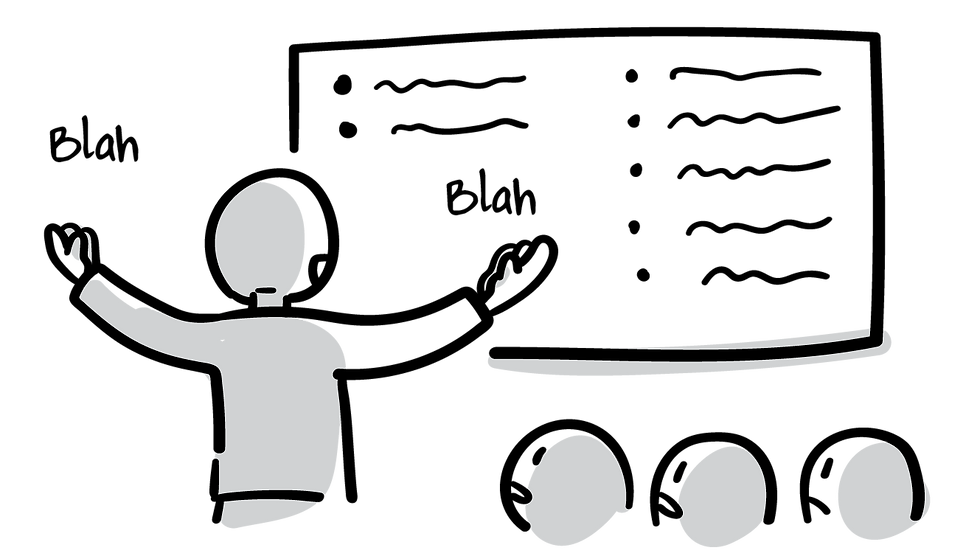Presenter Types — How can “Producers” cut clear of the clutter?
- Gavin McMahon

- Sep 30, 2021
- 4 min read
Updated: Oct 18, 2021

“Too much information will make your brain choke.”
Patrice ran Product.
She always had a huge amount of product information to communicate, and — to win hearts and minds — wanted to create a positive and engaging experience.
This led Patrice to over-prepare. Often, in order to cover the detail, she might copy Excel onto a slide and try to work her way through it in front of the audience. As slide after slide of dense information came up on the screen, Patrice would say ‘I know this looks like a bit of an eye-chart. I apologize that you can’t see it from the back.” She would then try to explain everything on her slides. “After all.” she reasoned…. ‘If it’s on the slide, I’d better speak to it’.
Poor Patrice, by using the slides as an autocue, she unwittingly became little more than talking PowerPoint.
One day..... Patrice noticed fewer and fewer people in the sales team showing up for her presentations. When she asked around, she found people were waiting for the handout rather than come and hear her just read it out loud.
Patrice was the type of presenter we call a Producer.
This is one of six types, along with Storyteller, Coach, Teacher, Counselor, and Inventor.
Producers use the sequence, Structure, Pictures, Words. If you think that might be you, read on.

A Producer is a logical and meticulous presenter, who gives well designed presentations.
If you’re a Producer, you develop a logical structure for a narrative, and a visual flow that allows the audience to form a clear picture of your subject.
Producers develop a flow that triggers their talktrack, and puts the audience in the picture.

Producers, ideally, would prefer to be in the audience rather than be the presenter, but can pull-off well organised, engaging presentations. They deliver structured content, delivered in a logical, well-prepared sequence. Producers also create visually meticulous slides that show a clear picture for the audience while triggering the presenter’s talk-track. Whether in person, or remote, this structured and methodical approach makes the presentation easier to follow.
Producers seek to make everything comprehensive for the audience -- thorough and all encompassing.
But, Producers struggle with attempting to cram far too much into a presentation.
Here’s the problem:
That drive to make the content all-encompassing can also make it impossible for those watching your presentation to tell the wood from the trees.
Producers bury the audience in more content than they can assimilate.

It’s precisely their comprehensiveness that can make Producers incomprehensible. Different sections of rigorously super-rich content start to blur into each other. The more you can streamline and spotlight the vital information you want your audience to understand, the more you can cut through the clutter.
Remember, every presentation has to compete for an audience’s attention.
Fear of not being able to find the right words in the moment leads Producers to overload their slides...
...and then attempt to read them.... point by painful point!
Using slides as a teleprompter breaks your connection with the audience.

This compels you to look at the slides and not at the audience, creating challenges around maintaining audience eye contact. The slides effectively become your teleprompter - lots of bullets and words, all packed with information. Even when remote, audiences can tell when a presenter is just reading the slides. This leads to a drop in engagement, so that the Producer is driven more heavily to stick rigidly to their structure.
Should anything derail that structure, the Producer is left flummoxed and speechless.
How Producers can clear the scrub and share the vision.
Edit, edit, edit! Less is more.
Producers benefit when they carve through the clutter and clarify their message.

It’s easy for Producers to over-pack a presentation and its slides. Especially when presenting remotely, dense content becomes unreadable. Where there are key words or phrases that need to be remembered, then do have those on the slides. Where information isn’t so essential, consider it for deletion.
The Click - Comment - Connect approach will then help you steer through the deck. To do this, use the elements on the slide to prompt memory and connect topics into the delivery.
First ‘Click’ to the next bullet, build, or slide. Then glance to the slide and ‘Comment’ on what it says — a Producer will find that the talktrack is all in their head and it’s better to say it naturally rather than follow a script. Finally, ‘Connect’ what was just said to the audience. “Joan, this is similar to your point on…”
With practice, Producers can smoothly navigate any presentation, whether face-to-face, or remote.
Gavin McMahon is a founder and Chief Learning and Product Officer for fassforward. He leads the design and product development of fassforward’s services. This crosses diverse topics, including leadership, culture, decision-making, information design, storytelling, and learning design.
Michael Flanagan is an Executive Advisor and Facilitator with fassforward. Michael has a deep Organization Effectiveness background. He facilitates both live and online learning experiences on a wide range of topics, including leadership development, presentation skills, critical thinking, and change management.
Peter Watts is a Senior Instructional Designer and Facilitator. He facilitates Live/online and tailored programs. Peter is fassforward's lead instructional designer for Live/online experiences. Live/online delivers mission-critical leadership and communications training, at scale, to business audiences around the world.
Eugene Yoon is a graphic designer and illustrator at fassforward. She is a crafter of Visual Logic.
Eugene is multifaceted and works on various types of projects, including but not limited to product design, UX and web design, data visualization, print design, advertising, and presentation design.







Comments